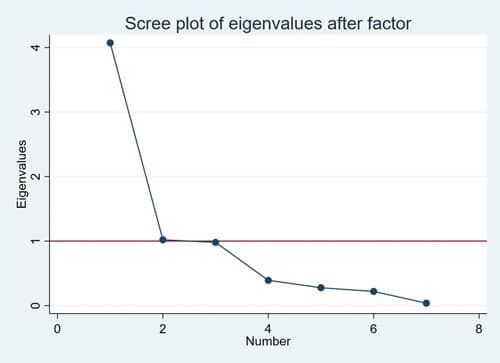How to Perform Exploratory Factor Analysis (EFA) in STATA Assignments
How to Perform Exploratory Factor Analysis (EFA) in STATA Assignments
Exploratory Factor Analysis (EFA) is a statistical analysis technique used in order to determine the extent of the relationships between the measured variables. EFA is used to unreveal the structure of a group of observed variables and does not enforce any predetermined structure making it ‘exploratory’. EFA is commonly used when it is required to make large and complex datasets simpler by focussing on few factors that describe the patterns in the data.

EFA is considered one of the most difficult topics for students as it consists of complex concepts such as finding the number of factors, suitable selection of rotation method and factor loading analysis. Learning these aspects demands solid foundational understanding of statistical theories as well as stata coding. These aspects are quite complex and are often overwhelming for many learners. To handle such challenges, we extend stata assignment help service acting as helping hand for solving various assignment problems associated with EFA. Let us start with the basics first.
What is Exploratory Factor Analysis (EFA)?
Exploratory Factor Analysis (EFA) is a statistical analysis technique studies the correlations between variables by grouping them into factors. Rather than testing a preconceived hypothesis about the data, the main objective of EFA is to examine the data structure and propose logical relationships.
EFA is typically used when:
- There is no prior theory or model describing the existence of number of factors and relation between variables.
- The researcher aims to find the structure of the data with no limitations.
- The purpose is to minimize the number of variables into smaller number of factors which can be easily analysed and interpreted.
Steps to Conduct EFA in STATA
Performing EFA in STATA involves several systematic steps, from data preparation to interpretation of results. Below is a step-by-step guide to conducting EFA in STATA:
Step 1: Data Preparation
It is important to pre-process the data before performing EFA. This step involves data cleaning, dealing with missing values, and make the data appropriate for performing factor analysis.
- Check for Missing Values: EFA assumes that there are no missing values or missing values have been appropriately handled.
- Ensure Adequate Sample Size: It is recommended that the dataset must have least 5-10 observations for each variable in order to obtain reliable results.
- Assess Factorability: Two important tests to determine if your data is appropriate for EFA are Bartlett’s Test of Sphericity and Kaiser-Meyer-Olkin (KMO) Measure of Sampling Adequacy.
* Example in STATA
use http://www.stata-press.com/data/r17/systolic, clear
mvdecode _all, mv(99)
summarize
Step 2: Test the Suitability of the Data for EFA
Before performing an EFA, it is necessary to test suitability of the data for factor analysis by Bartlett’s Test of Sphericity and KMO.
* Bartlett’s Test of Sphericity and KMO Measure
estat kmo, level(95)
estat bartlett
These tests enable one to decide whether the relationships between variables are big enough for factor analysis to be conducted.
Step 3: Extracting Factors
The next step in EFA is to extract factors from the data. This can be conducted using different extraction techniques including the Principal Component Analysis (PCA), Maximum likelihood, and Principal Axis Factoring among others. To perform this in STATA, the default method is called Principal Factor Analysis.
* Conducting EFA using Principal Factor Method
factor variable1 variable2 variable3 variable4, pcf
By using STATA, it will generate some factors and display an eigenvalue table. Any eigenvalue greater than 1 is suggestive of the fact that the factor can be retained as it captures more variance than a single observed variable.
Step 4: Deciding the Number of Factors to Retain
The decision of selecting number of factors to retain is important in EFA. This can be determined using:
- Eigenvalues: Retaining factors with eigenvalues greater than 1.
- Scree Plot: A visual representation of the eigenvalues which helps in identifying the elbow point where the explained variance by factors levels off.
- Parallel Analysis: A more advanced method which compares the eigenvalues from your data with those obtained from random data.
* Generating Scree Plot
factor variable1 variable2 variable3 variable4, pcf
screeplot, yline(1)
Step 5: Rotation of Factors
Factor rotation is done in order to obtain a more easily interpretable factor solution. Among all the rotations, Varimax and Promax rotations are the most popular one with the former being orthogonal rotation while the latter is oblique rotation.
* Applying Varimax Rotation
rotate, varimax
Rotation does not alter the chosen mathematical model for factors; however, making the output made more understandable.
Step 6: Interpretation of Factors
Now, the factors can be interpreted by analysing the factor loadings which depicts the strength of relationship between variables and factors. A factor loading matrix will display which variables group together under each factor
* Viewing Factor Loadings
matrix list e(L)
Step 7: Assessing the Model Fit
The last step involves assessing model fit. Chi-square tests, RMSEA, CFI and so on are offered by STATA in order to assess the goodness of fit.
* Assessing Model Fit
estat common
estat residuals
These fit indices help determine how well the model represents the data.
Example of EFA in STATA
Let us walk through a practical example using the built-in STATA dataset auto. This dataset includes several continuous variables that we can use to perform EFA.
* Load the STATA built-in dataset
sysuse auto, clear
* Check the data
summarize
* Perform Bartlett’s Test of Sphericity and KMO
estat kmo, level(95)
estat bartlett
* Conduct EFA using Principal Factor Method
factor price mpg rep78 headroom trunk weight length, pcf
* Generate Scree Plot
screeplot, yline(1)

* Apply Varimax Rotation
rotate, varimax
* View Factor Loadings
matrix list e(L)
* Assess Model Fit
estat common
estat residuals
EFA vs. CFA (Confirmatory Factor Analysis)
|
Aspect |
Exploratory Factor Analysis (EFA) |
Confirmatory Factor Analysis (CFA) |
|
Purpose |
Identifies underlying factor structure without predefined theory |
Tests hypotheses or confirms predefined factor structure based on theory |
|
Hypotheses |
No prior hypothesis; factors are discovered from the data |
Hypothesis-driven; specific factor structure is tested |
|
Model Specification |
Unspecified; aims to explore possible factor structures |
Explicitly specified; confirms or rejects a given model |
|
Data Requirements |
Generally used when little is known about the structure |
Requires a clear, theoretically-based model beforehand |
|
Rotation |
Often involves factor rotation (e.g., Varimax) to achieve simple structure |
No rotation typically used, as structure is predefined |
|
Typical Application |
Initial stages of research to explore possible factors |
Later stages to validate a hypothesized model |
Common Issues Students Face in Studying EFA and Its Applications in STATA
- Understanding EFA Concepts: Many students get confused with the EFA theoretical aspects like factor loadings, eigenvalues, and rotation types to name a few.
- Data Preparation and Suitability Testing: Some of the most common issues that many students face during data preparation steps are related to missing values and factorability.
- Choosing the Correct Number of Factors: Determining the accurate number of factors based on eigenvalues, scree plots, and parallel analysis can be difficult.
- Interpreting Factor Loadings: It was also seen that students face a lot of difficulties in interpretation of EFA especially the rotated factor loading matrix.
- STATA Command Syntax: Learning the codes and commands in STATA used for the EFA may confuse many students.
STATA Assignment Help to overcome EFA challenges
Our STATA Assignment Help is an expert service for helping students and research scholars in learning the statistical analysis procedure used to conduct EFA in STATA. Also, for student and research scholars, we offer plagiarism and AI free exhaustive data analysis reports based on latest version of STATA. Our high-quality solutions follow all university standards of writing and include a clear explanation of outputs, plots and tables. We attach stata do-file containing codes along with appropriate description of each line of code.
How Our Services Can Help
Opting for our STATA Homework Help services can assist students in overcoming these issues by:
- Providing Expert Guidance: Our qualified statisticians provide assistance based on individual needs of students and as per specific instructions given in the assignment.
- Assisting with Data Preparation: We provide assistance in cleaning and structuring data to conduct EFA.
- Step-by-Step Solutions: We give clear and specific instructions on how to do EFA using STATA from selecting the number of factors to interpretation of results.
- Customized Support: Our services are tailored to meet individual needs, whether it’s for coursework, assignments, or research projects.
Tips and Tricks
- Make sure that the data is suitable with KMO and Bartlett’s test before performing EFA.
- Use rotation methods to achieve a simpler, more interpretable factor structure.
- Regularly practice using STATA commands to become proficient in performing EFA.
If you are looking for a STAT homework doer having expertise in doing EFA, connect with us to engage with our world class experts.Experience better grades with our top-notch assignment solutions.
References and Further Reading
For those interested in learning more about EFA and its applications in STATA, the following references and textbooks are highly recommended:
- "Using Stata for Quantitative Analysis" by Kyle C. Longest - A beginner-friendly introduction to using STATA for various statistical analyses, including EFA.
- "Factor Analysis: A Short Introduction" by John A. Tucker - A concise guide that provides a good overview of factor analysis techniques.
Sarah Posted on 10-Sep-2024 18:36:00